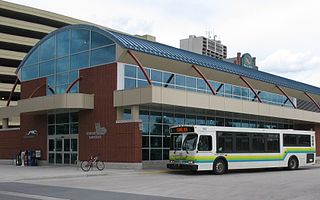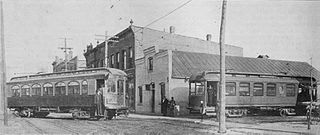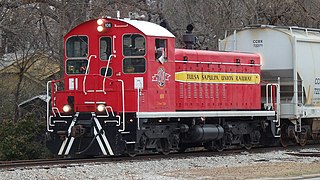Related Research Articles

The Pacific Electric Railway Company, nicknamed the Red Cars, was a privately owned mass transit system in Southern California consisting of electrically powered streetcars, interurban cars, and buses and was the largest electric railway system in the world in the 1920s. Organized around the city centers of Los Angeles and San Bernardino, it connected cities in Los Angeles County, Orange County, San Bernardino County and Riverside County.

The interurban is a type of electric railway, with tram-like electric self-propelled rail cars which run within and between cities or towns. The term "interurban" is usually used in North America, with other terms used outside it. They were very prevalent in many parts of the world before the Second World War and were used primarily for passenger travel between cities and their surrounding suburban and rural communities. Interurban as a term encompassed the companies, their infrastructure, their cars that ran on the rails, and their service. In the United States, the early 1900s interurban was a valuable economic institution, when most roads between towns, many town streets were unpaved, and transportation and haulage was by horse-drawn carriages and carts.

The San Diego Electric Railway (SDERy) was a mass transit system in Southern California, United States, using 600 volt DC streetcars and buses.

New York State Railways was a subsidiary of the New York Central Railroad that controlled several large city streetcar and electric interurban systems in upstate New York. It included the city transit lines in Rochester, Syracuse, Utica, Oneida and Rome, plus various interurban lines connecting those cities. New York State Railways also held a 50% interest in the Schenectady Railway Company, but it remained a separate independent operation. The New York Central took control of the Rochester Railway Company, the Rochester and Eastern Rapid Railway and the Rochester and Sodus Bay Railway in 1905, and the Mohawk Valley Company was formed by the railroad to manage these new acquisitions. New York State Railways was formed in 1909 when the properties controlled by the Mohawk Valley Company were merged. In 1912 it added the Rochester and Suburban Railway, the Syracuse Rapid Transit Railway, the Oneida Railway, and the Utica and Mohawk Valley Railway. The New York Central Railroad was interested in acquiring these lines in an effort to control the competition and to gain control of the lucrative electric utility companies that were behind many of these streetcar and interurban railways. Ridership across the system dropped through the 1920s as operating costs continued to rise, coupled with competition from better highways and private automobile use. New York Central sold New York State Railways in 1928 to a consortium led by investor E. L. Phillips, who was looking to gain control of the upstate utilities. Phillips sold his stake to Associated Gas & Electric in 1929, and the new owners allowed the railway bonds to default. New York State Railways entered receivership on December 30, 1929. The company emerged from receivership in 1934, and local operations were sold off to new private operators between 1938 and 1948.

The Chicago North Shore and Milwaukee Railroad, also known as the North Shore Line, was an interurban railroad that operated passenger and freight service over an 88.9-mile (143.1 km) route between the Chicago Loop and downtown Milwaukee, as well as an 8.6-mile (13.8 km) branch line between the villages of Lake Bluff and Mundelein, Illinois. The North Shore Line also provided streetcar, city bus and motor coach services along its interurban route.

The Yakima Valley Transportation Company was an interurban electric railroad headquartered in Yakima, Washington. It was operator of the city's streetcar system from 1907–1947, and it also provided the local bus service from the 1920s until 1957.

Transit Windsor provides public transportation in the city of Windsor, Ontario, Canada as well as LaSalle, Essex, Kingsville, Amherstburg and Leamington and serves more than 6 million passengers each year, covering an area of 310 km2 (120 sq mi) and a population of 235,000. They operate a cross border service between the downtown areas of Windsor and Detroit, Michigan via the Tunnel Bus, and service to events at Detroit's Comerica Park, Little Caesars Arena, Huntington Place, and Ford Field. The Windsor International Transit Terminal neighbours with the Windsor International Aquatic and Training Centre.

The Elgin and Belvidere Electric Company was a 36-mile (58 km) interurban line that connected Belvidere, Illinois and Elgin, Illinois. It was the central link in the interurban network connecting Freeport, Rockford, Elgin, and Chicago which included the Rockford and Interurban Railway to the west and the Chicago, Aurora and Elgin Railroad to the east. The line was operational from 1907 until 1930. In 1927, the line was extended to Rockford over a line of the Rockford and Interurban.
The Sand Springs Railway is a class III railroad operating in Oklahoma. It was originally formed in 1911 by industrialist Charles Page to connect his newly formed city of Sand Springs to Tulsa, operating both as a passenger carrying interurban and a freight carrier. At Sand Springs, the company also served his children's home, and Page directed all railroad profits to support the home's operations.

Transportation in Tulsa, Oklahoma includes a bus network and a system of raised highways and primary thoroughfares, laid out in mile-by-mile increments. In addition, throughout its entire length in Tulsa, historic Route 66 is a drivable road, with motels and restaurants reminiscent of the route's heyday era.

The Visalia Electric Railroad, a wholly owned subsidiary of the Southern Pacific Railroad (SP), began as an electric interurban railroad in Tulare County, in the U.S. State of California. The railroad was incorporated on April 22, 1904. Passenger service was discontinued in 1924, and the electrification was removed in 1944. Subsequent operation was by diesel locomotive. The railroad was closed in 1992.

Streetcars in St. Louis, Missouri, operated as part of the transportation network of St. Louis from the middle of the 19th century through the early 1960s.
The Scranton, Montrose and Binghamton Railroad Company was an interurban railway, commonly referred to as the Northern Electric railway, which ran between downtown Scranton, Pennsylvania, and its suburbs to the northwest, including Clarks Summit, Dalton, Factoryville and Montrose.

The Los Angeles Pacific Railroad (1896−1911) (LAP) was an electric public transit and freight railway system in Los Angeles County, California. At its peak it had 230 miles (370 km) of track extending from Downtown Los Angeles to the Westside, Santa Monica, and the South Bay towns along Santa Monica Bay.

Tulsa-Sapulpa Union Railway Company, L.L.C. is a Class III shortline rail carrier which operates freight service between Tulsa, Oklahoma and Sapulpa, Oklahoma over 10 miles of track known as the Sapulpa Lead, and which also leases and operates a 12.9 mile section of Union Pacific track known as the Jenks Industrial Lead between Tulsa and Jenks, Oklahoma. The line connects with two Class I railroads, being the Union Pacific at Tulsa and the BNSF at Sapulpa, and additionally connects to its fellow Class III shortline, the Sand Springs Railway, in Tulsa. It is owned by the Collins Family Trust. Major customers on the Sapulpa Lead include Technotherm, Prescor, and Ardagh Glass, and on the Jenks Industrial Lead, the HF Sinclair oil refinery, Kentube, Word Industries, Pepsi Cola, and Kimberly-Clark.
Streetcars in Redlands transported people across the city and region from 1889 until 1936. The city's network of street railways peaked around 1908 before the patchwork of separate companies was consolidated under the Pacific Electric.
The Pacific Electric Railway established streetcar services in Long Beach in 1902. Unlike other cities where Pacific Electric operated local streetcars, Long Beach's system did not predate the company's services. Long Beach's network of streetcars peaked around 1911 with over 30 miles (48 km) of tracks throughout the city. Local services were discontinued in 1940, but interurban service to Los Angeles persisted until 1961. The route of the former main interurban line was rebuilt in the late 1980s as the Metro Blue Line, which operates at-grade with car traffic for a portion of its length.
The predecessor rail lines which eventually came together as the Northeast Oklahoma Railroad (“NEO”) started as early as 1906, with some routes continuing until NEO was merged into the St. Louis-San Francisco Railroad (“Frisco”) in 1967. At its maximum, NEO ran approximately 34 miles of track in the area of the Tri-state mining district of southeast Kansas, northeast Oklahoma and southwest Missouri, although NEO itself only had operations in Kansas and Oklahoma.
References
- 1 2 3 4 5 6 7 8 "All Aboard! Take a Ride on the Bartlesville-Dewey Interurban". bmonthly Magazine, December 2021 (accessed on issuu.com). Retrieved April 8, 2024.
- ↑ "Bartlesville Interurban Railway Company, p. 39". Railroads of Oklahoma, June 6, 1870-April 1, 1978 (accessed on Oklahoma DigitalPrairie. Retrieved April 8, 2024.
- 1 2 3 4 5 "City preserves portion of 100-year-old Interurban Railway". City of Bartlesville. 17 October 2023. Retrieved April 8, 2024.
- 1 2 "In re Application of the Bartlesville Interurban Railway Company for leave to discontinue service". 1919. Retrieved April 10, 2024.